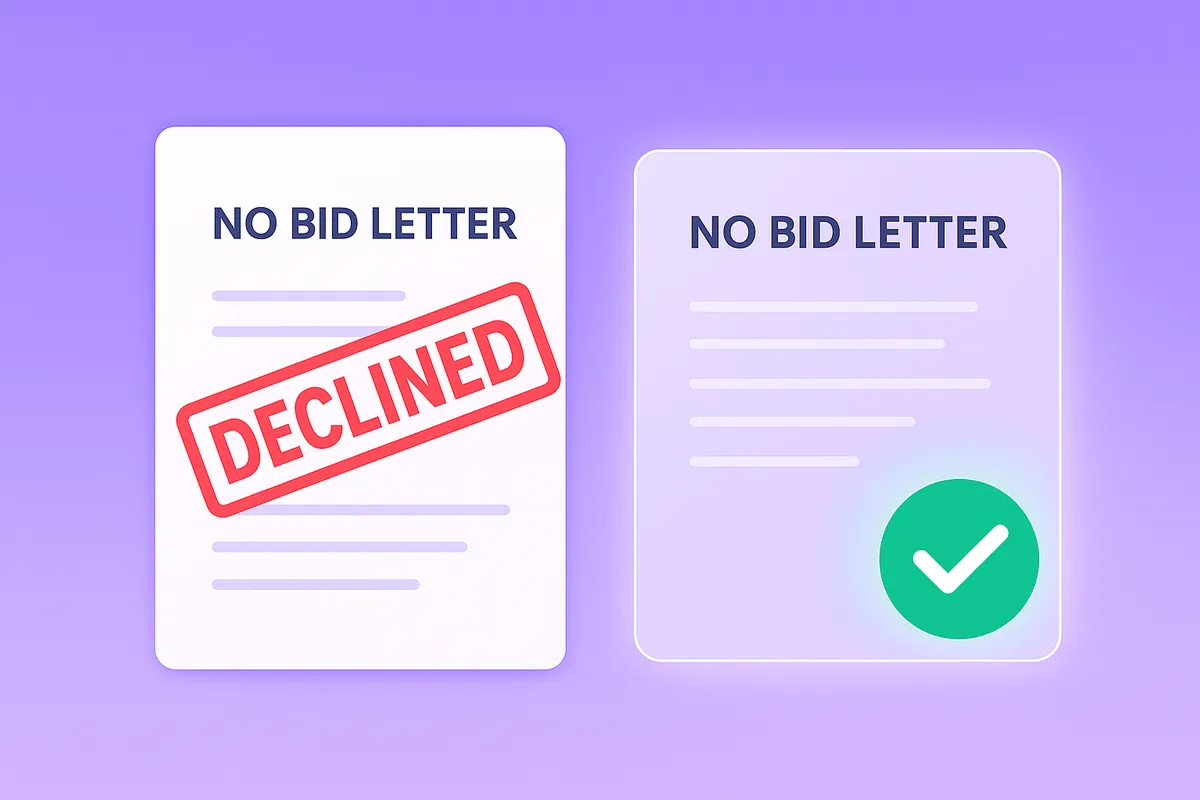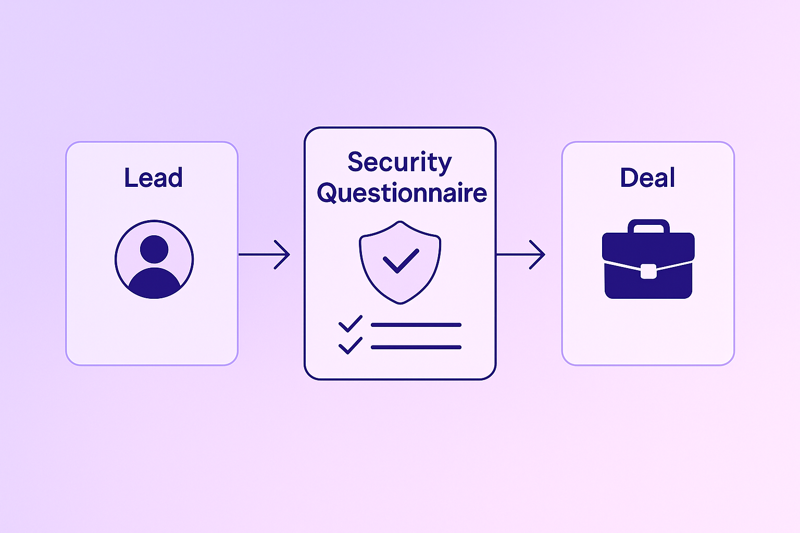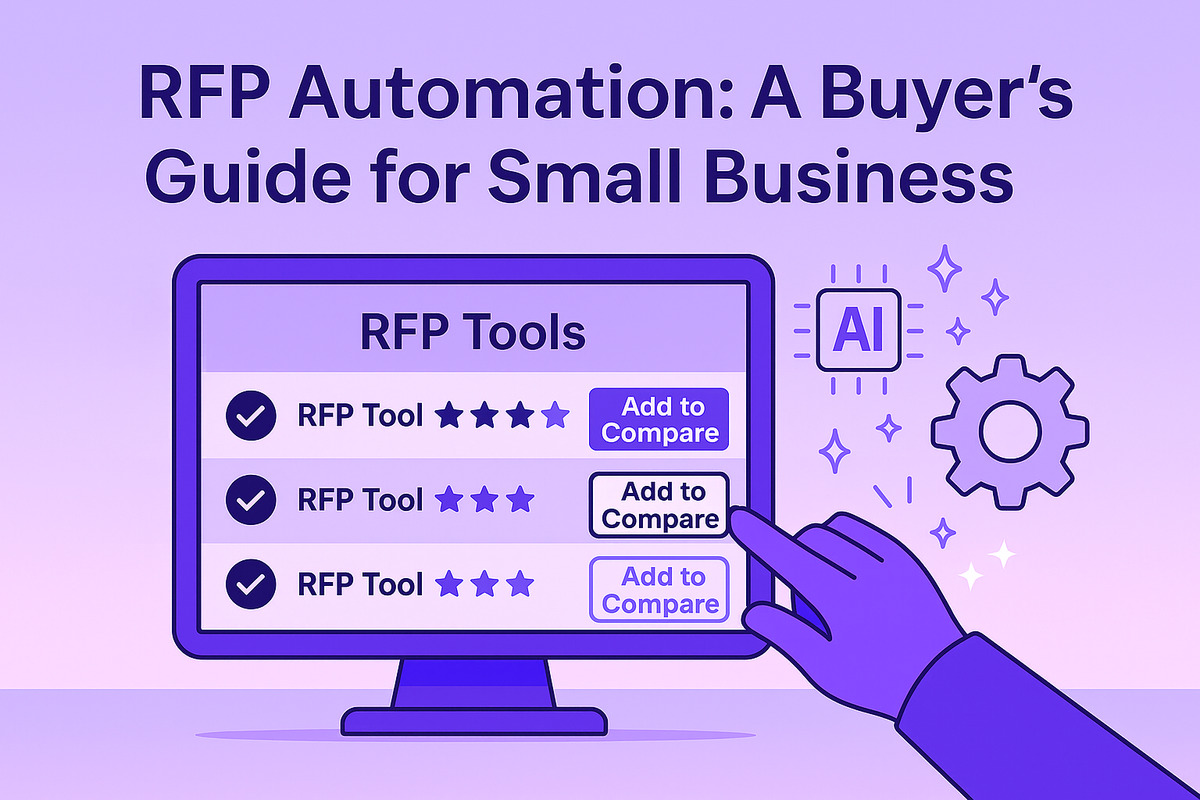No Bid Letter: How to Decline RFPs the Right Way
February 4, 2025
By
Evie Secilmis

Every interaction with a potential client is an opportunity to build a relationship, even when you're turning down their business. Pursuing an RFP that isn't a good fit can drain your resources and damage your reputation if you submit a weak proposal. Knowing when to walk away is a sign of a confident, strategic team. The key is to decline in a way that strengthens the connection for future opportunities. A thoughtful no bid letter does exactly that. It communicates respect for the issuer's time and positions your company as a discerning partner, keeping you top-of-mind for the right projects.
Why a Formal Bid/No-Bid Process is a Game-Changer
The Go/No-Go Decision: From Gut Feel to Smart Strategy
Let’s be honest, we’ve all been there. An RFP lands in your inbox, and your first instinct is to jump right in. But chasing every opportunity can stretch your team thin and lead to burnout. A bid/no-bid decision is a formal process that helps you decide whether to pursue a new project or pass on it. Instead of relying on a gut feeling, this framework forces you to pause and think logically. It’s a structured way to evaluate the pros and cons of an opportunity, ensuring you invest your team’s valuable time and resources where they’ll have the most impact. This strategic pause is the first step toward a more intentional and successful sales cycle.
Tools for a Data-Driven Decision
Implementing a formal bid/no-bid process helps you focus your energy on the deals you’re most likely to win. The goal isn’t just to pick the right projects; it’s also about confidently walking away from the ones you’re likely to lose. Regularly using this process can significantly improve your win rate and help you secure more valuable contracts. Once you’ve used these tools to identify a high-potential RFP, the next step is to deliver a compelling response quickly. Having an AI-powered proposal platform like Iris allows your team to generate high-quality first drafts in minutes, turning that smart "go" decision into a winning submission without missing a beat.
The Simple Checklist
If you’re just starting to formalize your decision-making, the simple checklist is the perfect tool. It’s exactly what it sounds like: a straightforward list of questions you ask about every potential project. Do we have a strong relationship with this client? Do we have a unique solution they can’t get elsewhere? Can we meet the deadline without sacrificing quality? You run through the list, and if you find yourself answering "yes" to most questions, it’s a strong signal to move forward. If you’re hitting a lot of "no" or "yes, but..." answers, it might be a sign that this opportunity isn’t the right fit for you right now.
The Weighted Decision Matrix
For a more nuanced approach, you can use a weighted decision matrix. This tool takes the simple checklist a step further by assigning a level of importance, or a "weight," to each question. For example, having a prior relationship with the client might be more critical to your success than your ability to meet a tight deadline, so you’d give it a higher weight. After answering each question, you calculate a total score based on your answers and their corresponding weights. This method gives you a clearer, more quantitative picture of your chances, helping you move beyond a simple yes or no to see just how strong an opportunity really is.
The Decisive Decision Tree
The decision tree is the most advanced and structured of the three tools. Think of it as a flowchart that guides you through a series of questions in a specific order. This model often includes "knockout" questions early in the process. For instance, a key question might be, "Is this project profitable?" If the answer is no, the decision tree might immediately direct you to a "no-bid" conclusion, saving you from wasting any more time analyzing the opportunity. It’s a stricter, more efficient way to make a call, ideal for teams that want to enforce a clear and decisive qualification process before committing any resources to a proposal.
How to Politely Decline an RFP
Not every RFP request is the right fit. Pursuing the wrong opportunities can drain resources, stretch teams thin, and reduce win rates. Knowing when to politely decline an RFP while keeping the door open for future business is a crucial skill for revenue teams.
A well-crafted no-bid letter ensures your company remains professional, maintains strong relationships, and leaves a lasting impression—even when you choose to pass. Unlike traditional relational database-driven RFP tools, Iris’s generative AI and agentic automation help teams make smarter bid/no-bid decisions by analyzing past wins, response effectiveness, and opportunity alignment.
Here’s how to craft a no-bid response that strengthens future opportunities rather than shutting them down.
1. Respond Quickly and Professionally
The sooner you communicate your decision to decline, the better. Companies issuing RFPs often operate on tight deadlines and appreciate early notice when a vendor opts out. Delayed responses can harm relationships and damage credibility.
The High Cost of Ghosting an RFP
When your team is swamped with deadlines, it’s tempting to let an ill-fitting RFP slide by without a response. But in the professional world, ghosting a potential client is a surefire way to burn a bridge. Simply ignoring a request to bid makes your company look disorganized and unprofessional, and it can seriously harm your chances of being considered for future projects from that organization. You never know when the perfect opportunity might come from them next.
Failing to respond is a missed opportunity to build goodwill. A thoughtful no-bid letter, on the other hand, shows respect for the issuer's time and effort. It communicates that you value the relationship even if the current project isn't the right fit. This simple, professional courtesy keeps the door open for better-aligned collaborations down the road, turning a 'no' for now into a potential 'yes' for later. It’s a small investment in maintaining a positive industry reputation.
How to Craft a Professional Response
- Acknowledge receipt of the RFP or security questionnaire quickly.
- Be clear and concise about your decision.
- Offer a brief, professional explanation without unnecessary detail.
A simple, well-structured no-bid letter maintains credibility while leaving room for future engagement.
Use Official Letterhead and Proofread Carefully
Think of your no-bid letter as an official piece of business correspondence, not just a quick email. Using your company's letterhead is a simple way to signal that you're taking the request seriously, even though you're declining. It adds a layer of formality and respect that a plain message might lack, showing the issuing company that you value their time and the opportunity they presented. This small touch reinforces your brand's professionalism and sets you apart from others who might send a hasty, informal note. It’s a strategic move that helps maintain a polished image and keeps the relationship strong for any future collaborations that might be a better fit.
Before you hit send, give your letter a thorough proofread. A message filled with typos or grammatical mistakes can undermine the goodwill you've built and make your company look careless—the last impression you want to leave. A sloppy response might even suggest that your company's approach to client work is equally rushed. A quick review ensures your response is clear, professional, and accurately reflects your company's commitment to quality. If possible, have a teammate give it a second look for a fresh perspective. Taking these extra minutes is a crucial step in professional communication and helps preserve your reputation for future opportunities.
2. Briefly Explain Your "Why"
Avoid generic responses like “we are unable to participate at this time.” Instead, provide a thoughtful, specific reason—but keep it brief.
Valid Reasons for Declining a Bid
- Misalignment: The opportunity doesn’t fit your AI-powered RFP automation capabilities.
- Resource Constraints: Your team’s current bandwidth prevents a high-quality response.
- Budget Considerations: The expected investment isn’t aligned with your business model.
If applicable, mention any future scenarios where you might reconsider bidding.
Unrealistic Timelines or Unfavorable Terms
An aggressive timeline or unfavorable contract terms are more than just red flags—they're valid reasons to walk away from an RFP. If a deadline is so tight that it compromises your team's ability to deliver a quality response, it's not a winning opportunity. The same goes for contract terms that put your business at a disadvantage. Saying 'no' in these situations isn't about admitting defeat; it's a strategic decision to protect your team's bandwidth and your company's long-term health. This is the perfect scenario for writing a professional no-bid letter. It allows you to decline gracefully, briefly explain your reasoning, and maintain a positive relationship for future opportunities that are a better fit.
Turn Your "No" into a Negotiation
Declining an RFP doesn't have to be the end of the conversation. Think of it as a strategic pivot. A thoughtful "no" can actually strengthen a relationship by showing you respect the issuer's time and are committed to projects where you can deliver maximum value. The goal of a no-bid letter isn't just to decline the work; it's to politely pass while keeping the door wide open for the future. This approach positions you as a discerning partner, not just a vendor chasing every opportunity, which builds trust and credibility for the long term.
This is your chance to influence the buyer and reshape the dialogue. If the scope is misaligned or the requirements are unclear, your feedback can be a "golden opportunity" to educate them on what a successful partnership could look like. You can explain why it's not a fit and subtly guide them toward a future RFP that better aligns with your strengths. This transforms your decline from a simple rejection into a valuable consultation, ensuring you stay on their list of preferred vendors for future, more suitable projects.
3. Leave the Door Open for the Future
Just because you’re declining now doesn’t mean the door is closed. A well-crafted no-bid letter should leave a positive impression and keep you top-of-mind for future projects.
Tips for Maintaining a Good Relationship
- Express gratitude for the opportunity.
- Show continued interest in working together in the future.
- Offer an alternative, such as a meeting to discuss potential alignment down the road.
An effective no-bid response builds goodwill and keeps your team in consideration for future deals.
When to Pick Up the Phone
While a formal no-bid letter is standard practice, sometimes a phone call is the better move. If you have a strong, established relationship with the client, picking up the phone adds a personal touch that an email can't replicate. A direct conversation shows you value the relationship beyond this single opportunity and gives you a chance to explain your decision with more nuance. It reinforces that your "no" is about fit or timing, not a lack of interest in their business. This simple gesture can do wonders for maintaining goodwill and ensures you're the first person they think of for the next project. You can always follow up with a brief, formal letter for their records after the call.
A Simple No Bid Letter Template You Can Use
Subject: Thank You for the RFP Opportunity
Dear [Client Name],
Thank you for considering [Your Company] for [Project Name]. We appreciate the opportunity to review your RFP/security questionnaire and the time your team has invested in sharing details with us.
After careful consideration, we have decided not to submit a proposal at this time due to [brief reason—e.g., current priorities, project alignment, or resource constraints]. However, we remain highly interested in supporting [Client’s Company] in the future and would love to stay in touch about upcoming opportunities.
We truly value our relationship and appreciate the chance to collaborate in other ways. Please don’t hesitate to reach out if there’s an opportunity to discuss future projects.
Best regards,
[Your Name]
[Your Position]
[Your Contact Information]
[Your Company Name]
Key Best Practices for Your Bidding Process
A disciplined bidding process is your secret weapon for sustainable growth. It’s not about chasing every opportunity that lands in your inbox; it’s about strategically choosing the right ones and handling every interaction with professionalism. When you treat the bidding process as a core part of your sales strategy, you stop wasting resources on long-shot deals and start focusing your energy where it counts. This approach protects your team from burnout and positions your company as a thoughtful, reliable partner. Adopting a few key practices can transform your response process from a reactive scramble into a proactive, revenue-driving machine that strengthens relationships, whether you win the deal or not.
A Weak Proposal is Worse Than No Proposal
It’s tempting to throw your hat in the ring for every RFP, but submitting a rushed or half-hearted proposal can do more harm than good. A weak submission not only signals to the client that you might not be the right fit, but it also reflects poorly on your brand’s commitment to quality. It’s far better to decline an opportunity gracefully than to submit a proposal that doesn’t showcase your best work. Sending a professional no-bid letter shows respect for the client's time and preserves the relationship for future opportunities that are a better match. This strategic decision protects your reputation and ensures your team’s efforts are spent on deals you can confidently win.
Communicate Your Intent to Bid
Clear and prompt communication is fundamental to building trust. As soon as you’ve made your go/no-go decision, let the issuer know. If you’re declining, a quick response allows them to adjust their evaluation process accordingly. They’re often working on a tight deadline, and your professionalism won’t go unnoticed. Similarly, if you decide to move forward, sending a formal intent to bid confirms your interest and establishes a professional tone from the start. This simple step helps you keep a good relationship with the client, manages expectations, and keeps the lines of communication open, setting the stage for a positive and productive engagement regardless of the final outcome.
Make Faster Bid/No-Bid Decisions with AI
With Iris’s generative AI and agentic automation, teams can make smarter bid/no-bid decisions based on data-driven insights, past performance, and opportunity alignment. By leveraging AI for RFP responses, businesses can focus their resources on high-value opportunities and optimize proposal strategies.
Looking to streamline your RFP process and make smarter decisions? Visit heyiris.ai to see how AI-driven RFP automation can transform your workflow.
Frequently Asked Questions
Won't declining an RFP hurt my chances of working with that company in the future? It’s a common fear, but the opposite is actually true. When you decline an RFP professionally, you show respect for the issuer's time and your own. It communicates that you’re a strategic partner who only pursues projects where you can deliver exceptional value, rather than a vendor just chasing any contract. This thoughtful approach builds credibility and keeps you top-of-mind for future opportunities that are a much better fit for your team.
How much detail should I really give when explaining why we're not bidding? The key is to be clear but concise. You don't need to write a detailed report, but a vague "we're unable to participate" can feel dismissive. A brief, honest reason like a misalignment with your core services, current resource constraints, or an unrealistic timeline is enough. This provides helpful context without oversharing and maintains a professional, transparent relationship.
Is it ever okay to just ignore an RFP if my team is swamped? Never. Ignoring a request, or "ghosting," is one of the fastest ways to damage your professional reputation and burn a bridge with a potential client. Taking five minutes to send a polite no-bid letter shows respect and keeps the door open for future collaborations. It’s a small investment that protects your company’s image and your network.
My team doesn't have a formal process for this. What's the easiest way to start? The best way to begin is with a simple checklist. You don't need a complex system right away. Just create a short list of essential questions to ask for every opportunity that comes in. Questions like, "Do we have a strong relationship with this client?" or "Can we realistically meet this deadline?" will help your team move from making gut-based decisions to having a more structured and logical conversation about which deals are worth pursuing.
When should I send a letter versus making a phone call to decline? A formal no-bid letter or email is the standard and works well for most situations. However, if you have a strong, established relationship with the person who sent the RFP, a phone call can be a better choice. A direct conversation adds a personal touch that reinforces the value you place on the relationship, making it clear that your decision is about this specific project, not about your interest in working with them. You can always follow up with a brief email for their records.
Key Takeaways
- Establish a formal bid/no-bid process: Use structured tools like checklists or decision matrices to evaluate opportunities logically. This ensures you invest your team's valuable time on the deals you're most likely to win, protecting resources and improving your win rate.
- Decline with purpose to strengthen relationships: When an RFP isn't a good fit, send a prompt, professional no-bid letter. Briefly explaining your reasoning and expressing interest in future collaboration maintains goodwill and keeps the door open for better-aligned projects.
- Prioritize quality over quantity in your proposals: Submitting a rushed proposal can damage your brand's reputation more than not bidding at all. Strategically declining protects your team's focus for opportunities where you can deliver your best work and confidently win.
Related Articles
Share this post
Link copied!



















